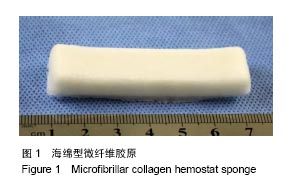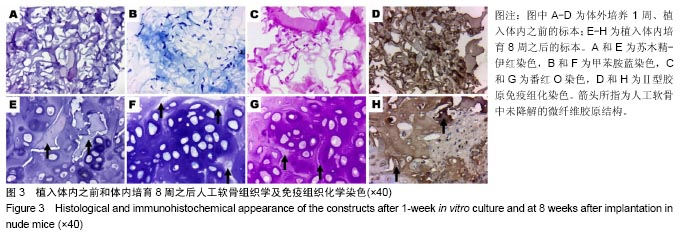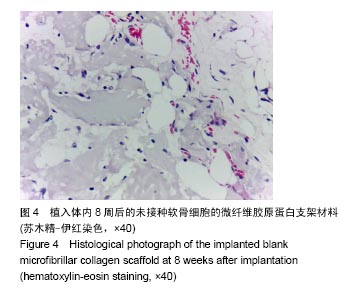| [1]Bichara DA, O'Sullivan NA, Pomerantseva I, et al. The tissue-engineered auricle: past, present, and future. Tissue Eng Part B Rev. 2012;18(1):51-61.[2]Wu L, Zhang H, Zhang J, et al. Fabrication of three-dimensional porous scaffolds of complicated shape for tissue engineering. I. Compression molding based on flexible-rigid combined mold. Tissue Eng. 2005;11(7-8):1105-1114.[3]Lin X, Wang W, Zhang W, et al. Hyaluronic Acid Coating Enhances Biocompatibility of Nonwoven PGA Scaffold and Cartilage Formation. Tissue Eng Part C Methods. 2017; 23(2):86-97.[4]Toosi S, Naderi-Meshkin H, Kalalinia F, et al. PGA-incorporated collagen: Toward a biodegradable composite scaffold for bone-tissue engineering. J Biomed Mater Res A. 2016;104(8):2020-2028.[5]Jiang L, Li Y, Xiong C, et al. Preparation and Properties of Bamboo Fiber/Nano-hydroxyapatite/Poly(lactic-co-glycolic) Composite Scaffold for Bone Tissue Engineering. ACS Appl Mater Interfaces. 2017;9(5):4890-4897.[6]Cao Y, Xiong D, Wang K, et al. Semi-degradable porous poly (vinyl alcohol) hydrogel scaffold for cartilage repair: Evaluation of the initial and cell-cultured tribological properties. J Mech Behav Biomed Mater. 2017;68:163-172.[7]Frasca S, Norol F, Le Visage C, et al. Calcium-phosphate ceramics and polysaccharide-based hydrogel scaffolds combined with mesenchymal stem cell differently support bone repair in rats. J Mater Sci Mater Med. 2017;28(2):35.[8]Shirakata Y, Nakamura T, Shinohara Y, et al. An exploratory study on the efficacy of rat dedifferentiated fat cells (rDFATs) with a poly lactic-co-glycolic acid/hydroxylapatite (PLGA/HA) composite for bone formation in a rat calvarial defect model. J Mater Sci Mater Med. 2014;25(3):899-908.[9]Moura D, Mano JF, Paiva MC, et al. Chitosan nanocomposites based on distinct inorganic fillers for biomedical applications. Sci Technol Adv Mater. 2016;17(1):626-643.[10]Fujioka-Kobayashi M, Mottini M, Kobayashi E, et al. An in vitro study of fibrin sealant as a carrier system for recombinant human bone morphogenetic protein (rhBMP)-9 for bone tissue engineering. J Craniomaxillofac Surg. 2017;45(1):27-32. [11]Zhou L, Pomerantseva I, Bassett EK, et al. Engineering ear constructs with a composite scaffold to maintain dimensions. Tissue Eng Part A. 2011;17(11-12):1573-1581.[12]Schweiger M, Knirsch W, Cesarovic N, et al. Surgical technique: establishing a pre-clinical large animal model to test aortic valve leaflet substitute. J Thorac Dis. 2016;8(12): 3733-3738.[13]Kesireddy V, Kasper FK. Approaches for building bioactive elements into synthetic scaffolds for bone tissue engineering. J Mater Chem B Mater Biol Med. 2016;4(42): 6773-6786.[14]Lam AT, Li J, Toh JP, et al. Biodegradable poly-ε-caprolactone microcarriers for efficient production of human mesenchymal stromal cells and secreted cytokines in batch and fed-batch bioreactors. Cytotherapy. 2017;19(3):419-432.[15]Radhakrishnan J, Subramanian A, Krishnan UM, et al. Injectable and 3D Bioprinted Polysaccharide Hydrogels: From Cartilage to Osteochondral Tissue Engineering. Biomacromolecules. 2017;18(1):1-26.[16]Kiyotake EA, Beck EC, Detamore MS. Cartilage extracellular matrix as a biomaterial for cartilage regeneration. Ann N Y Acad Sci. 2016;1383(1):139-159.[17]Schneider C, Lehmann J, van Osch GJ, et al. Systematic Comparison of Protocols for the Preparation of Human Articular Cartilage for Use as Scaffold Material in Cartilage Tissue Engineering. Tissue Eng Part C Methods. 2016;22(12): 1095-1107.[18]Eslahi N, Abdorahim M, Simchi A. Smart Polymeric Hydrogels for Cartilage Tissue Engineering: A Review on the Chemistry and Biological Functions. Biomacromolecules. 2016;17(11):3441-3463.[19]Asghari F, Samiei M, Adibkia K, et al. Biodegradable and biocompatible polymers for tissue engineering application: a review. Artif Cells Nanomed Biotechnol. 2017;45(2):185-192.[20]Qi N, Li WJ, Tian H. A systematic review of animal and clinical studies on the use of scaffolds for urethral repair. J Huazhong Univ Sci Technolog Med Sci. 2016;36(1):111-117.[21]Thomas D, Gaspar D, Sorushanova A, et al. Scaffold and scaffold-free self-assembled systems in regenerative medicine. Biotechnol Bioeng. 2016;113(6):1155-1163.[22]Fujimoto Y, Kobayashi T, Komori M, et al. Modified hemostatic technique using microfibrillar collagen hemostat in endoscopic endonasal transsphenoidal surgery: technical note. Neurol Med Chir (Tokyo). 2014;54(8):617-621.[23]Struk D, Rankin RN, Karlik SJ. Stability studies on chemoembolization mixtures. Dialysis studies of doxorubicin and lipiodol with Avitene, Gelfoam, and Angiostat. Invest Radiol. 1993;28(11):1024-1027.[24]Minkin P, Bertetti R, Lindsey S, et al. Management of tooth extraction in a patient with a rare bleeding disorder associated with Hermansky-Pudlak syndrome: a case report. J Oral Maxillofac Surg. 2015;73(2):219-223.[25]Magro-Ernica N, Magro-Filho O, Rangel-Garcia I. Histologic study of use of microfibrillar collagen hemostat in rat dental sockets. Braz Dent J. 2003;14(1):12-15.[26]Sirlak M, Eryilmaz S, Yazicioglu L, et al. Comparative study of microfibrillar collagen hemostat (Colgel) and oxidized cellulose (Surgicel) in high transfusion-risk cardiac surgery.J Thorac Cardiovasc Surg. 2003;126(3):666-670.[27]Horton JW, Garcia NM, Stone KR. Evaluation of a new hemostatic agent in experimental splenic laceration. Arch Surg. 1995;130(2):161-164.[28]Watanabe G, Misaki T, Kotoh K. Microfibrillar collagen (Avitene) and antibiotic-containing fibrin-glue after median sternotomy. J Card Surg. 1997;12(2):110-111.[29]Robicsek F. Microfibrillar collagen hemostat in cardiac surgery. J Thorac Cardiovasc Surg. 2004;127(4):1228.[30]钟江龙,张大明,陈伟良,等.经口内镜辅助下切除咽旁间隙良性肿瘤6例报道[J].中国口腔颌面外科杂志, 2015, 13(3):258-261.[31]罗伟初,谢道远,李翠芳,等.63例人工髋关节置换手术的治疗体会[J].中国当代医药, 2012, 19(10):28-30.[32]陈运,邵大畏,任伟业,等.胶原海绵填充甲状腺手术残腔与止血疗效临床观察[J].中国医药指南, 2012, 10(5):79-80.[33]缪雪华,周勇,任伟业,等.胶原海绵促进肉芽生长与创面愈合实验研究[J].中国当代医药, 2012, 19(10):26-27.[34]周勇,任伟业,邵大畏,等.胶原海绵促进创面止血与血管新生的实验研究[J].湖南中医杂志, 2012, 28(3):140-141.[35]Wagner WR, Pachence JM, Ristich J, et al. Comparative in vitro analysis of topical hemostatic agents. J Surg Res. 1996; 66(2):100-108.[36]Ereth M, Sibonga J, Oliver W, et al. Microporous polysaccharide hemospheres do not inhibit bone healing compared to bone wax or microfibrillar collagen. Orthopedics. 2008;31(3):222.[37]Doita M, Nishida K, Kurosaka M. Radiculopathy due to microfibrillar collagen hemostat mimicking recurrence of disc herniation. Skeletal Radiol. 2006;35(12):953-955.[38]Zhou L, Ding R, Li B, et al. Cartilage engineering using chondrocyte cell sheets and its application in reconstruction of microtia. Int J Clin Exp Pathol. 2015;8(1):73-80.[39]于美丽, 杜智. 可吸收止血材料的研究现状及临床应用[J].北京生物医学工程, 2008,27(2):208-211.[40]O'Shaughnessy BA, Schafernak KT, DiPatri AJ Jr, et al. A granulomatous reaction to Avitene mimicking recurrence of a medulloblastoma. Case report. J Neurosurg. 2006;104 (1 Suppl):33-36. |
.jpg)




.jpg)
.jpg)